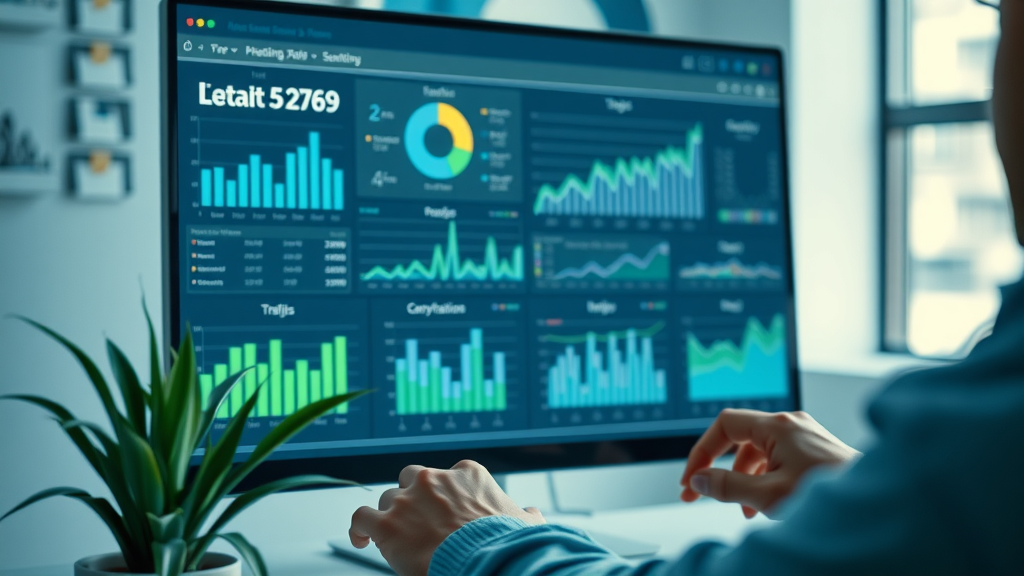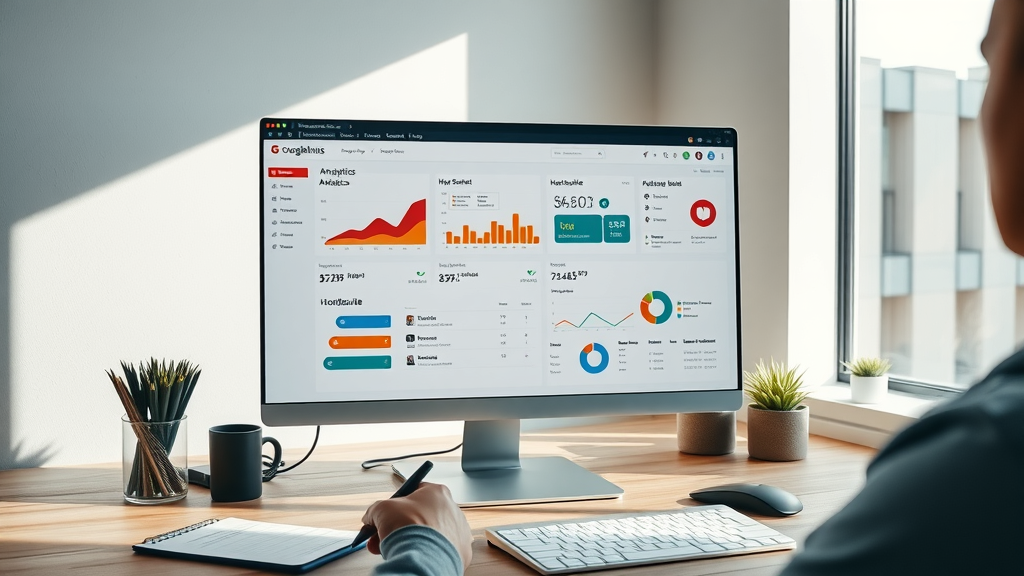What if tracking just a handful of content marketing metrics could transform your marketing from good to industry-leading? The fact is, companies who track key content marketing metrics are 4x more likely to see ROI increases (Forrester). Whether you’re a marketing pro or a business leader, understanding and acting on these metrics is the secret to smarter growth and unbeatable results. This article will unveil the must-track metrics, tips for reporting, and the best tools so you can find—and leverage—actionable data for your content market strategy.
If you want to finally prove your marketing ROI , avoid wasted effort, and set your business apart, read on: you’re about to learn how to unlock the potential of every piece of content you publish.
Why Content Marketing Metrics Matter: A Surprising Look at Data-Driven Growth
"Companies who track key content marketing metrics are 4x more likely to see ROI increases, according to recent Forrester research."
- Uncover how data shapes strategy, spot high-impact opportunities, and avoid costly blind spots in your content market approach.

Empowering Your Strategy: How Content Marketing Metrics Drive Performance
- Build a framework for measuring content marketing performance
- Elevate your marketing campaign with actionable insights
- Set meaningful KPIs using proven marketing metrics
Understanding content marketing metrics is essential for building a framework that measures real impact. Every effective marketing strategy depends on insights derived from performance data. By tracking metrics at every stage of your content marketing campaign, you get more than just vanity numbers—you get guidance on where to focus your marketing efforts for optimal returns. Analytics reveal which blog posts, landing pages, or social media content resonate with your target audience .
Even the most creative pieces of content fall short without a way to measure their effectiveness. Setting meaningful KPIs around your content market objectives, such as increasing site traffic or improving engagement metrics, ensures that each marketing metric leads to real business outcomes. When you know precisely which types of engaging content trigger higher conversion rates or social shares, you can laser-focus your marketing efforts for exponential growth.
Ultimately, a data-driven content marketing strategy helps you avoid pitfalls, reallocate resources to top-performing assets, and track progress toward your revenue goals. Every click, share, and comment is a potential insight—if you know which content marketing metric to watch.
Master These Essential Content Marketing Metrics for ROI
| Content Marketing Metric | Definition | Why It Matters | How to Track |
|---|---|---|---|
| Traffic | Number of visitors | Measures reach | Google Analytics |
| Bounce Rate | % visitors leaving quickly | Assesses relevance | GA, Hotjar |
| Conversion Rate | % completing desired action | Measures ROI | GA, CRM |
| Social Shares | Number of shares | Amplifies brand awareness | Native analytics |
| Time on Page | Average time on content | Indicates engagement | GA |
| Email Open Rate | % emails opened | Reveals email marketing impact | ESP reports |

Content Marketing Campaign Success: Setting Smart Goals
- Identify your marketing metric priorities (site traffic, engagement, conversion)
- Link each goal to content marketing metrics that matter
- Monitor, assess, and adapt based on content performance
Achieving repeated content marketing campaign success starts by clearly identifying your business objectives. Is your goal to increase site traffic , improve engagement metrics such as time on page, or boost your overall conversion rate? Prioritizing these objectives will help you select the right content marketing metric for your strategy.
Once you’ve identified your priorities, directly link your goals to relevant content marketing metrics . For example, if increasing brand awareness is key, monitor metrics like social shares and direct traffic. If lead generation is your top aim, focus on conversion rate and audience segmentation data. Continually monitoring these metrics allows you to assess performance and make agile adjustments to your marketing campaign for better results.
By setting actionable and measurable goals, you empower your team to adapt based on real-time feedback. Tracking content performance ensures every marketing effort is intentional, cost-effective, and aligned with broader business outcomes.
Tracking Site Traffic: The Foundation of Content Marketing Metrics
Site traffic is the backbone of all content marketing metrics. When you measure the number of visitors, both new and returning, you get a bird's-eye view of your digital reach. A consistent increase in site traffic signals that your blog posts, landing pages, and social media promotions are resonating with your target audience. Not only does this indicate greater brand visibility, but it also primes your content market for improved engagement metrics.
Using data from Google Analytics and other tools to analyze site traffic helps you spot which channels, sources, and specific pieces of content are most effective for your brand. By breaking down your traffic by device, channel (organic, paid, referral, direct), and even geographic location, you can adapt your content marketing metrics to align with your audience’s behaviors and preferences. This in-depth understanding enables you to invest most efficiently in the channels and marketing strategies that actually move the needle.
Without robust efforts to monitor and optimize site traffic, even the most engaging content can get lost—underscoring the importance of this foundational marketing metric in your overall measurement approach.
Understanding Google Analytics for Content Marketers
- Key GA dashboards for content marketers
- Utilizing site traffic, bounce rate, and time on page data
- Setting up content marketing metric custom reports
Google Analytics is the gold standard for tracking content marketing metrics related to site traffic, user engagement, and conversion rate. For content marketers, configuring key dashboards that monitor bounce rate, average time on page, and user flow is essential. These dashboards provide a snapshot of how your target audience interacts with each marketing campaign, allowing you to identify high-performing blog posts and optimize weaker assets.
The ability to create custom reports tailored to your content marketing strategy accelerates insights and action. By monitoring detailed metrics, such as landing page performance, exit rates, and even custom engagement events, you build a granular picture of your audience journey. This data enables you to pinpoint friction points, capitalize on content that resonates, and refine your overall content market approach for sustained growth.
In short, investing the time to master Google Analytics can pay massive dividends—empowering your content marketer team to transition from intuition to informed, data-driven marketing efforts.

Measuring Engagement Metrics: Deeper Insights Into Your Content Marketing
Content Performance Metrics: Engagement, Time on Page, and More
"Content marketers who regularly review engagement metrics increase user retention rates by 37%."
- Time on page
- Pages per session
- Social shares
- Comments and interactions
Engagement metrics like time on page , pages per session, and social shares provide deep insight into how well your content resonates with visitors. If your content keeps users engaged for extended periods, it’s likely providing genuine value and addressing their pain points. Conversely, a high bounce rate might suggest your piece of content misses the mark, motivating you to tweak it for better relevance or clarity.
Monitoring engagement metrics can also identify which topics, blog posts, or formats your audience prefers. Social shares, comments, and interactions amplify brand awareness while serving as powerful social proof that can drive further traffic and conversions. Metrics like these move beyond superficial numbers to show how your marketing campaign is performing in the real world.
If you’re striving for impact, engagement metrics must be at the center of your content marketing metric tracking. They make it easy to spot high-ROI topics and optimize the user journey—every marketing strategy should leverage them for sustainable growth.

Conversion Rate Optimization: The Pinnacle of Content Marketing Metrics
From Lead to Customer: How to Attribute Content Marketing Metrics to Real ROI
- Setting up conversion tracking for marketing campaigns
- Interpreting conversion rate data
- Linking content marketing efforts to sales outcomes
Maximizing your conversion rate is the ultimate goal of every content marketing campaign . By setting up accurate conversion tracking—whether for form submissions, downloads, or sales—you gain direct insight into which content truly drives business results. Integrating Google Analytics with your CRM ensures that every lead and sale can be attributed to the right content marketing efforts, closing the loop from engagement to revenue.
Careful interpretation of conversion rate data reveals which messaging, calls to action, and content formats best move prospects through the funnel. You can see, for example, how a well-optimized landing page built on engaging content can multiply conversion rates, while content that fails to resonate may slow down your ROI growth entirely. Data-driven adjustments make every piece of content work harder, transforming your strategy into a scalable marketing engine.
The key is linking content marketing metric results back to your sales pipeline. This holistic approach ensures every dollar invested in content market activity works double duty—attracting, nurturing, and closing valuable customers for your business.

Advanced Content Marketing Metrics: Beyond the Basics
Tracking Brand Awareness With Content Market Initiatives
- Direct and branded search traffic
- Social media mentions
- PR and influencer engagement
While traffic and conversions are pillars, advanced marketers also track brand awareness metrics for comprehensive content market success. Metrics like branded search volume, direct website visits, and increased social media mentions provide early indicators of a growing reputation and loyal following. Monitoring PR coverage and influencer engagement also helps quantify your brand’s reach in both online and offline spaces.
These advanced content marketing metrics shed light on the long-term impact of your efforts, beyond immediate clicks or sales. For example, an uptick in branded search queries suggests your content is sticking in people’s minds, increasing trust and recall. By tying initiatives like thought leadership blog posts or viral social shares to uplift in these metrics, you see the holistic value your content strategy delivers.
Incorporating brand awareness measurement into regular reporting ensures your content marketing efforts yield both short-term gains and lasting business equity, fueling continuous growth in a competitive market.
Audience Segmentation: How Target Audience Metrics Refine Strategy
- Segment performance by blog post types
- Personalize content marketing campaigns
- Use behavior data to modify content
Effective content marketers constantly segment their target audience to reveal what works best for each group. For example, you might compare how educational versus product-focused blog posts perform with different segments. These audience insights empower you to design and deliver content marketing campaigns that truly connect and inspire action.
Personalization is a key driver of content performance . By using behavior data and firmographics, marketers can tailor messages, offers, and visuals for segments most likely to convert. Adapting your content strategy in this way increases engagement, lowers bounce rate, and dramatically boosts overall marketing ROI.
Continuous refinement—backed by robust audience segmentation and analytics—ensures your content always feels relevant, timely, and valuable to the people who matter most.

Social Media Content Marketing Metrics: Amplify Your Reach
The Power of Social Shares and Engagement in Content Market Success
| Social Platform | Key Metric | Typical Benchmarks |
|---|---|---|
| Engagement Rate | 0.09%–1% | |
| Shares | 0.5%–1% | |
| Retweets | 0.02%–.1% | |
| Saves/Shares | 0.5%-2% |
- Tracking social media marketing metrics for each channel
- Using engagement metrics for future campaigns
Social media platforms are powerful amplifiers for your content marketing strategy. Tracking metrics such as engagement rates, shares, retweets, and saves enables marketers to assess which types of content resonate with their audience. These social media metrics not only enhance brand awareness, but also inform your future marketing campaigns by revealing top themes and formats.
Each social platform has different typical benchmarks—what works on Instagram may fall flat on LinkedIn or Twitter. A careful channel-by-channel approach, coupled with robust analytics, helps pinpoint high-ROI opportunities in your content market mix. The faster you can analyze what’s working, the quicker you can adapt your marketing strategy and sprint ahead of the competition.
Ultimately, leveraging social shares, engagement metrics, and comparative performance data ensures your content marketing efforts create a lasting ripple effect throughout your industry.

Blog Posts, Email Marketing, and Content Performance: Cross-Channel Success
Blog Post Metrics: Measuring What Matters
- Pageviews per article
- Time on page
- Scroll depth
For every blog post , important metrics like pageviews, time on page, and scroll depth provide direct feedback on content performance. High pageviews combined with longer dwell time mean your blog posts are attracting, informing, and retaining visitors—key to SEO and authority in your niche.
Tracking scroll depth adds extra nuance, helping you identify exactly where users lose interest. This allows you to optimize calls-to-action, insert more engaging content, or refine your formatting. As blog posts remain one of the primary channels for thought leadership, in-depth analysis ensures every piece of content in your strategy delivers tangible, compounding returns.
By consistently measuring these blog post metrics, you’ll understand exactly what your audience wants, which boosts conversion rates and strengthens your content market foundation.
Email Marketing Metrics for Content Marketers
- Open and click rates
- List growth and engagement
- Conversion driven by email campaigns
With email marketing still delivering the highest ROI of any digital channel, it pays to monitor key metrics—open rate, click-through rate, and conversions—to maximize your results. A healthy email list fuels content distribution, increases repeat engagement, and drives users back to your website.
Growth and engagement metrics show whether your messaging, subject lines, and calls-to-action are aligned with your target audience’s real interests. Tracking conversions—such as downloads, purchases, or sign-ups—links every email marketing campaign to a measurable business impact, allowing your team to double down on the tactics that drive results.
By integrating email marketing data with broader content performance analytics, you’ll unlock new layers of insight and cross-pollinate your content marketing efforts for truly exponential growth.

Making Sense of Content Marketing Metrics Data: Analytics Tools and Dashboards
Best Tools for Tracking and Reporting on Content Marketing Metrics
| Tool | Primary Function | Content Marketing Metric Tracked |
|---|---|---|
| Google Analytics | Web analytics | Site traffic, bounce rate, conversion rate |
| HubSpot | Automation/CRM | Lead tracking, attribution |
| BuzzSumo | Social/content | Social shares, backlinks |
| Hootsuite | Social management | Scheduling, engagement |

Streamlining analysis is key for time-strapped marketing teams. Modern dashboards, powered by tools like Google Analytics , HubSpot, Hootsuite, or BuzzSumo, collect and visualize your most important marketing metrics in one place. These platforms aid in real-time tracking of site traffic, bounce rate, conversion rate, and social media shares, making it easier to spot trends and pivot quickly.
Choosing the right tools depends on your reporting needs, campaign objectives, and tech stack. Investing in robust analytics platforms ensures that your data informs tactical shifts and strategic decisions, grounding every content marketing effort in measurable results.
Leverage these tools to provide stakeholders with clear, visual reports that showcase both the “what” and the “why” behind performance changes, enabling faster buy-in and more confident business decisions.
Effective Reporting: Presenting Content Marketing Metrics to Stakeholders
- Craft visual reports highlighting ROI-focused marketing metrics
- Use storytelling and data visualization
- Translate raw content marketing data into actionable business insights
"Marketing metrics without action are just numbers. True leaders use content marketing metrics to inspire change—and growth."

Translating raw content marketing metric data into business insights sets leading teams apart. Effective reporting relies on clean visuals, clear narrative, and actionable takeaways. Custom dashboards and infographics are critical for presenting complex information to stakeholders in an approachable, ROI-driven way.
By embedding case studies or key wins within your reporting, you make it easy for decision-makers to see the value of continued investment in content marketing. Data-driven storytelling helps move conversations from “what happened” to “what’s next”, inspiring informed strategic shifts and rapid growth.
As a result, your marketing metrics become more than just numbers—they’re catalysts for innovation, budget increases, and cross-team alignment.
Avoiding Common Pitfalls: Misinterpreting Content Marketing Metric Data
- Top missteps when tracking marketing metrics
- How to choose the right content marketing metric for your goals
- Ensuring data accuracy and consistency

Even the most detailed reporting can miss the mark if the wrong content marketing metrics are chosen or misinterpreted. One common error is overemphasizing vanity metrics, like raw pageviews, while ignoring critical context—such as bounce rate or conversion data. To avoid misleading conclusions, always align your analytics to strategic business objectives and measure the impact of each piece of content with a clear hypothesis in mind.
Maintaining data integrity is crucial. This means conducting regular audits for tracking codes, cross-referencing marketing metrics from multiple sources, and establishing clear documentation for every metric collected. Consistent and accurate data ensures your team’s decisions reflect true performance, not just noise.
When in doubt, focus on content marketing metrics that directly inform action—prioritizing those with a clear connection to revenue, growth, or engagement.
People Also Ask: Unlocking Key Questions About Content Marketing Metrics
What is KPIs in content marketing?
- KPIs in content marketing are Key Performance Indicators: quantifiable targets used to track the effectiveness of your content marketing metric strategy. They align with business objectives, such as increasing site traffic, engagement, or conversions.
What are the 3 C's of content marketing?
- The 3 C's in content marketing are: Creation (developing valuable content), Curation (selecting and sharing relevant content), and Conversion (using content to drive desired marketing metrics and business outcomes).
What are the 4 Ps of content marketing?
- The 4 Ps are: Plan (strategy/goal setting with content marketing metrics), Produce (content creation), Publish (distribute across channels), and Promote (drive engagement and measure marketing campaign results).
What are the 4 E's of content marketing?
- The 4 Es in content marketing are: Educate (provide valuable knowledge), Engage (stimulate interaction), Entertain (captivate audience attention), and Empower (inspire action through content performance tracking).
Pro Tips: Maximizing ROI with the Right Content Marketing Metrics
- Focus on marketing metrics that map directly to revenue
- Continuously optimize campaigns using engagement metrics
- Review and recalibrate your KPIs quarterly
Take a laser-focused approach—prioritize the content marketing metrics that map directly to sales or defined business goals. Leverage engagement metrics to adapt your strategy in real-time, and don’t be afraid to refine your KPIs every quarter to stay aligned with market trends.
Frequently Asked Questions About Content Marketing Metrics
- How do I choose the right content marketing metric for my business?
- Which metrics indicate content performance for B2B brands?
- How often should I report on content marketing metrics?
- Are there industry benchmarks for marketing metrics?
- What tools help automate content marketing metric reporting?
Identify your primary business goals and select content marketing metrics that tie directly to those objectives. For example, if lead generation is key, prioritize conversion rate and qualified leads over pure pageviews.
B2B brands should track metrics like leads generated, engagement (pages per session, time on page), and conversion rates. Pipeline growth and account engagement provide further clarity.
Regular reporting is fundamental. Weekly or bi-weekly reporting suits active campaigns, while monthly or quarterly reviews help spot broader trends.
Yes, industry benchmarks vary by sector and channel. Compare your metrics against published standards to spot outliers and improvement opportunities.
Tools such as Google Analytics, HubSpot, Hootsuite, and BuzzSumo automate data collection and visualization for real-time and historical reporting.
Take Your Content Market Results Further — Start Assessing Your Content Marketing Metrics Now
"Don’t leave your ROI to chance. True growth comes when you take control with data-driven content marketing metrics."
- Call us at (385) 469-1869 or email at info@solu4u.com today!
Key Insights: Elevate Your Content Marketing Metrics Strategy for Next-Level ROI
- Content marketing metrics are essential for optimizing strategy and maximizing impact on ROI.
- Use a layered approach from site traffic to conversion rate to fully understand your content performance.
- Cross-channel analysis—social media, blog posts, email—reveals deep insights into your marketing campaign effectiveness.
- Continually refine your strategy, leveraging robust analytics and clear reporting to stakeholders.
- Stay ahead by focusing on the metrics that truly measure your content market growth and ROI.
Conclusion
Start transforming your marketing results: track, analyze, and act on your most impactful content marketing metrics—then watch your ROI soar.
Sources
- https://www.forrester.com
- https://blog.hubspot.com/marketing/content-marketing-metrics
- https://contentmarketinginstitute.com
- https://www.brightedge.com/resources/webinars/content-marketing-metrics
- https://sproutsocial.com/insights/social-media-metrics/
- https://support.google.com/analytics
To enhance your understanding of content marketing metrics and their impact on ROI, consider exploring the following authoritative resources:
-
“27 Definitions for Effective Content Marketing Measurement” : This comprehensive guide from the Content Marketing Institute provides clear definitions and explanations of key content marketing metrics, helping you measure and improve your content’s performance. ( contentmarketinginstitute.com )
-
“14 Content Marketing Metrics to Track for Success” : Offered by Semrush, this article outlines essential metrics to monitor, such as conversion rates and engagement times, to effectively assess and enhance your content marketing strategies. ( semrush.com )
By delving into these resources, you’ll gain valuable insights into tracking and optimizing your content marketing efforts for maximum ROI.
 Add Row
Add Row  Add
Add 




Write A Comment